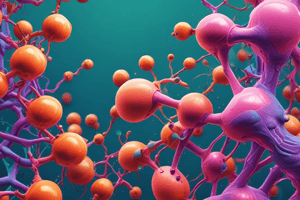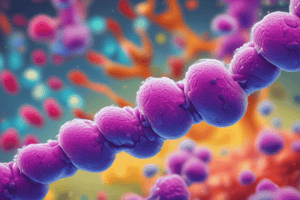Podcast
Questions and Answers
Which of the following is NOT a characteristic of peptide or protein hormones?
Which of the following is NOT a characteristic of peptide or protein hormones?
- Oxytocin is an example of a peptide hormone
- Glucagon is an example of a peptide hormone
- They are hydrophobic in nature (correct)
- Insulin is an example of a peptide hormone
Which of the following is an example of a steroid hormone?
Which of the following is an example of a steroid hormone?
- Oxytocin
- Insulin
- Estrogen (correct)
- Glucagon
Which of the following hormones uses cyclic guanosine monophosphate (cGMP) as a second messenger?
Which of the following hormones uses cyclic guanosine monophosphate (cGMP) as a second messenger?
- Adrenocorticotropic hormone (ACTH)
- Atrial natriuretic peptide (ANP) (correct)
- Gastrin
- Follicle-stimulating hormone (FSH)
Which of the following statements about Group I hormones is NOT true?
Which of the following statements about Group I hormones is NOT true?
Which of the following categories of Group II hormones uses phosphatidylinositol/calcium as a second messenger?
Which of the following categories of Group II hormones uses phosphatidylinositol/calcium as a second messenger?
Which of the following statements about amino acid derivatives is true?
Which of the following statements about amino acid derivatives is true?
Which of the following statements about hormone receptors is true?
Which of the following statements about hormone receptors is true?
Which of the following hormones uses cyclic adenosine monophosphate (cAMP) as a second messenger?
Which of the following hormones uses cyclic adenosine monophosphate (cAMP) as a second messenger?
Which of the following statements about the classification of hormones based on their mechanism of action is true?
Which of the following statements about the classification of hormones based on their mechanism of action is true?
Which of the following hormones is NOT an example of a hormone that uses phosphatidylinositol/calcium as a second messenger?
Which of the following hormones is NOT an example of a hormone that uses phosphatidylinositol/calcium as a second messenger?
Flashcards are hidden until you start studying
Study Notes
Hormones Definition
- Hormones are chemical messengers released from ductless glands into the bloodstream to regulate the activity of other tissues.
Classification of Hormones
- Based on chemical nature:
- Peptide or protein hormones: examples include insulin, glucagon, antidiuretic hormone, and oxytocin.
- Steroid hormones: examples include glucocorticoids, mineralocorticoids, and sex hormones.
- Amino acid derivatives: examples include epinephrine, norepinephrine, thyroxine (T4), and triiodothyronine (T3).
Classification Based on Mechanism of Action
Group I Hormones
- Action is mediated via intracellular receptors.
- Examples include glucocorticoids, estrogens, progesterone, mineralocorticoids, calcitriol, and thyroxine.
Group II Hormones
- Action is mediated via cell surface receptors and second messengers.
- Hydrophilic in nature.
- Divided into three categories based on second messengers:
- Hormones using cyclic adenosine monophosphate (cAMP) as second messenger:
- Examples include adrenocorticotropic hormone (ACTH), follicle-stimulating hormone (FSH), luteinizing hormone (LH), parathormone (PTH), and adrenaline.
- Hormones using phosphatidylinositol/calcium as second messenger:
- Examples include thyrotropin-releasing hormone (TRH), gonadotropin-releasing hormone (GnRH), gastrin, and chole cystokinin (CCK).
- Hormones using cyclic guanosine monophosphate (cGMP) as second messenger:
- Example is atrial natriuretic peptide (ANP).
- Hormones using cyclic adenosine monophosphate (cAMP) as second messenger:
Studying That Suits You
Use AI to generate personalized quizzes and flashcards to suit your learning preferences.




